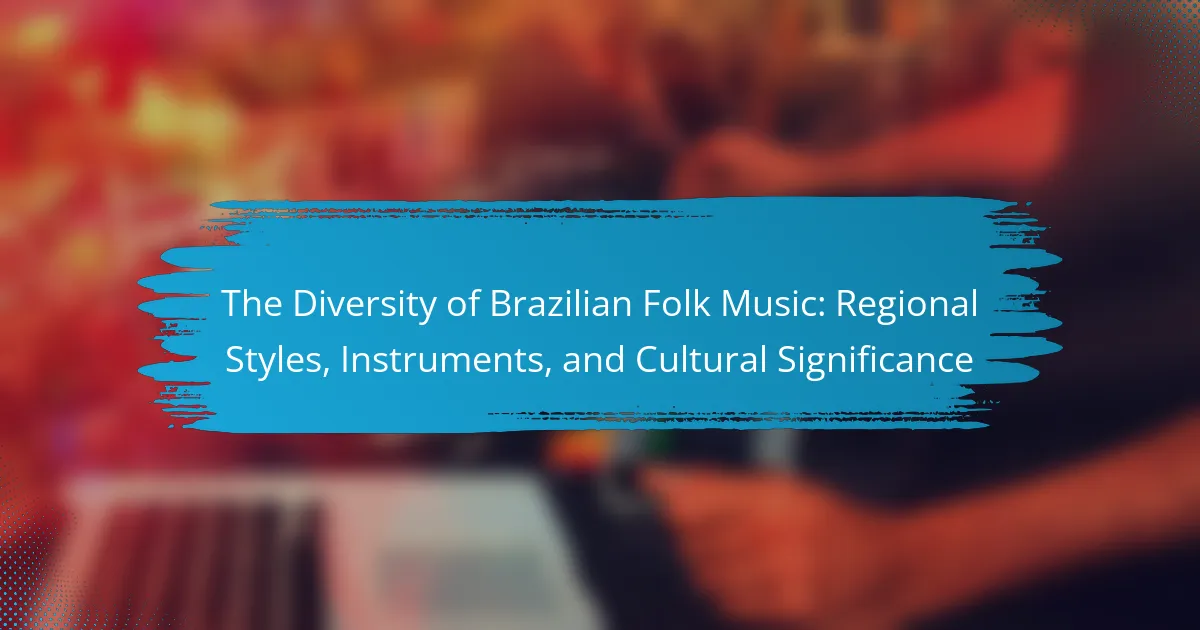Brazilian folk music encompasses a rich diversity of regional styles, each influenced by Indigenous, African, and European cultures. Key genres include Samba from Rio de Janeiro, Forró from the Northeast, and Sertanejo from the rural Midwest, among others. Instruments such as the berimbau, cavaquinho, and pandeiro are integral to these musical forms, contributing to the cultural significance of folk music in Brazil. This genre serves as a medium for storytelling and community identity, reflecting the country’s historical narratives and social issues. Overall, Brazilian folk music is a vital expression of national heritage and cultural complexity.
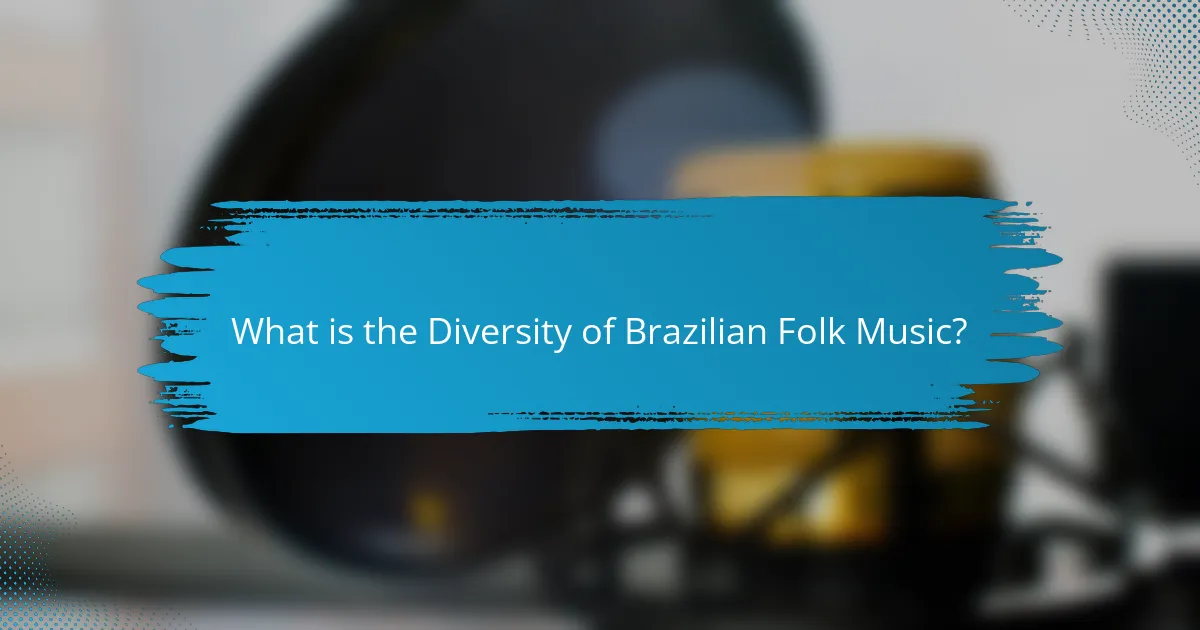
What is the Diversity of Brazilian Folk Music?
Brazilian folk music is characterized by its rich diversity stemming from various regional styles. Each region of Brazil contributes unique musical traditions influenced by Indigenous, African, and European cultures. For instance, the Northeast is known for genres like Forró and Axé, while the South features traditional music like Chamamé and Milonga. The Amazon region showcases unique sounds through indigenous instruments and rhythms. Additionally, instruments such as the Berimbau and Cavaquinho play vital roles in these musical forms. This diversity reflects Brazil’s cultural complexity and historical influences. The wide array of styles and instruments highlights the country’s vibrant heritage and communal expressions through music.
How did Brazilian Folk Music originate and evolve?
Brazilian folk music originated from a blend of indigenous, African, and European musical traditions. This fusion began during the colonial period in the 16th century. Indigenous peoples contributed unique rhythms and instruments. African slaves brought rich musical heritage, including call-and-response patterns. European settlers introduced instruments like the guitar and violin. Over time, regional styles emerged, each reflecting local culture and history. For example, the Nordeste region is known for forró, while the South features traditional gaucho music. The evolution continued into the 20th century with the rise of genres like samba and bossa nova. These developments showcased Brazil’s diverse cultural landscape and influenced global music.
What historical influences shaped Brazilian Folk Music?
Brazilian Folk Music is shaped by diverse historical influences. Indigenous cultures contributed unique rhythms and instruments. African slaves brought rich musical traditions and vocal styles. European colonization introduced various musical forms, including Portuguese fado. The merging of these influences created distinct regional styles. For example, the Northeast blends African and Indigenous elements. The South showcases European influences in its folk traditions. Historical events, such as the abolition of slavery, also impacted musical evolution. These factors combined to form a rich tapestry of Brazilian Folk Music.
How have cultural exchanges impacted its development?
Cultural exchanges have significantly impacted the development of Brazilian folk music. These exchanges have introduced various musical styles, instruments, and rhythms from different cultures. African, Indigenous, and European influences are particularly prominent. For instance, African rhythms have shaped samba and other genres. Indigenous melodies contribute to the unique sound of regional folk music. European instruments, such as the guitar and accordion, have been integrated into local traditions. This blending of influences has created a rich tapestry of sounds. The result is a diverse musical landscape that reflects Brazil’s multicultural heritage. Cultural festivals and gatherings further promote these exchanges, allowing for continuous evolution.
What are the key characteristics of Brazilian Folk Music?
Brazilian folk music is characterized by its rich diversity, regional variations, and unique instruments. It incorporates various styles such as Samba, Forró, and Bossa Nova. Each style reflects the cultural influences of different regions in Brazil. The music often features traditional instruments like the Berimbau, Cavaquinho, and Pandeiro. Rhythmic complexity is a hallmark, with syncopation and polyrhythms commonly used. Lyrically, Brazilian folk music often tells stories of daily life, love, and social issues. The music is also closely tied to dance, with specific movements associated with each genre. Festivals and communal gatherings often showcase these musical forms, reinforcing cultural identity.
What musical elements define Brazilian Folk Music?
Brazilian Folk Music is defined by its diverse rhythmic patterns, melodic structures, and instrumentation. Key elements include syncopated rhythms, often derived from African influences. Instruments such as the berimbau, cavaquinho, and pandeiro are commonly used. Melodies often incorporate traditional scales, reflecting indigenous and European influences. The use of call-and-response vocals is prevalent in many folk traditions. Additionally, regional variations contribute unique characteristics to the music. For example, the rhythms of samba differ significantly from those of forró. This diversity showcases the cultural richness and historical evolution of Brazilian Folk Music.
How do regional variations influence its characteristics?
Regional variations significantly influence the characteristics of Brazilian folk music. Each region showcases distinct musical styles, instruments, and cultural influences. For example, the Northeast is known for rhythms like forró and axé, which reflect African and Indigenous heritage. In contrast, the South features traditional gaucho music, emphasizing the influence of European immigrants.
Instruments also vary regionally. The berimbau is prevalent in Bahia, while the accordion is essential in the Northeast. These differences create unique soundscapes that represent local identities. Furthermore, regional festivals often highlight specific musical traditions, fostering community pride.
Research shows that these variations contribute to Brazil’s rich cultural tapestry and promote diversity in musical expression. The unique attributes of each region’s folk music illustrate how geography and history shape cultural practices.
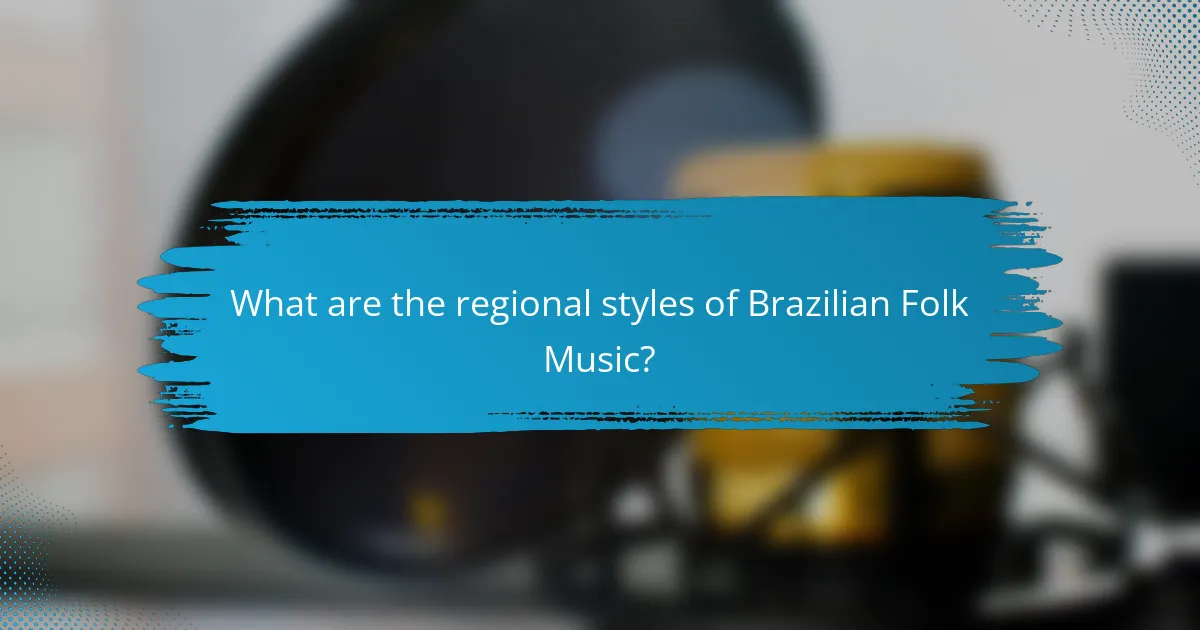
What are the regional styles of Brazilian Folk Music?
Brazilian folk music features several regional styles, each with unique characteristics. The primary styles include Samba from Rio de Janeiro, which is known for its rhythmic beats and lively dance. Forró originates from the Northeast and combines accordion, zabumba, and triangle instruments. Axé music is popular in Bahia, blending African rhythms and Brazilian sounds. Sertanejo is a country music style from the rural Midwest, often featuring themes of love and life in the countryside. Maracatu, also from Pernambuco, incorporates Afro-Brazilian traditions and vibrant percussion. These styles reflect Brazil’s diverse cultural heritage and regional influences. Each genre contributes to the rich tapestry of Brazilian folk music, showcasing the country’s musical variety.
Which regions of Brazil have distinct folk music styles?
Brazil has several regions with distinct folk music styles. The Northeast is known for forró and axé music. The Southeast features samba and bossa nova. The South is recognized for traditional gaucho music, such as vanerão. The Central-West showcases sertanejo, which is popular in rural areas. Each region’s music reflects its cultural heritage and influences. For example, forró has African, Indigenous, and European roots. Samba originated in Afro-Brazilian communities in Rio de Janeiro. The diversity of instruments, rhythms, and dance styles further highlights this regional variation.
What are the defining features of folk music from the Northeast?
Folk music from the Northeast of Brazil is characterized by its rich rhythms, diverse instruments, and cultural storytelling. The region showcases unique styles such as forró, frevo, and maracatu. These styles often feature lively percussion instruments like the zabumba and triangle. The music serves as a medium for expressing local traditions and social issues. Lyrics frequently reflect the daily lives and struggles of the people. The use of improvisation is common, allowing for personal expression. Festivals in the Northeast celebrate these musical traditions, drawing large crowds and fostering community. This vibrant folk music is integral to the cultural identity of the Northeast region.
How does the South’s folk music differ from that of the North?
The South’s folk music features distinct rhythms and instruments compared to the North’s. Southern folk music often incorporates the accordion and guitar, reflecting European influences. In contrast, Northern folk music prominently features indigenous instruments like the berimbau and flutes. The lyrical themes also differ; Southern songs frequently focus on rural life and love, while Northern songs often highlight nature and [censured]. Additionally, the South’s music tends to have a more structured form, whereas the North’s is often more improvisational. This differentiation is rooted in the diverse cultural backgrounds of each region, with the South influenced by European settlers and the North shaped by indigenous traditions.
What are some prominent genres within Brazilian Folk Music?
Prominent genres within Brazilian Folk Music include Samba, Forró, and Axé. Samba originated in Rio de Janeiro and is characterized by its rhythmic beats and lively dance. Forró, popular in the Northeast, features accordion and zabumba, creating a festive atmosphere. Axé blends African, Caribbean, and Brazilian influences, often seen in Carnival celebrations. Each genre reflects regional cultural heritage and social history. Samba, for instance, has roots in Afro-Brazilian communities and has evolved over decades. Forró’s dance style is integral to Brazilian festivities, showcasing community bonding. Axé music has gained international popularity, representing Brazil’s vibrant culture.
What is the significance of Samba in Brazilian Folk Music?
Samba is a vital genre in Brazilian folk music. It represents the cultural identity and social history of Brazil. Originating from African rhythms, Samba evolved in the early 20th century. It became popular during the Carnival celebrations in Rio de Janeiro. Samba is characterized by its syncopated rhythms and lively dance. The genre fosters community and cultural expression among Brazilians. Samba schools play a crucial role in preserving and promoting this art form. They engage in competitions that showcase creativity and tradition. Samba’s significance lies in its ability to unite diverse communities through music and dance.
How does Forró reflect the culture of Northeast Brazil?
Forró reflects the culture of Northeast Brazil through its music, dance, and social gatherings. It originated in the rural areas and is deeply connected to local traditions. The genre incorporates instruments like the accordion, zabumba, and triangle, which are emblematic of the region. Forró lyrics often tell stories of daily life, love, and struggles faced by the people. Festivals celebrating Forró, such as São João, highlight its role in community bonding and cultural identity. The energetic dance style encourages participation and fosters a sense of belonging among attendees. Overall, Forró serves as a cultural expression that showcases the history and resilience of the Northeast Brazilian people.
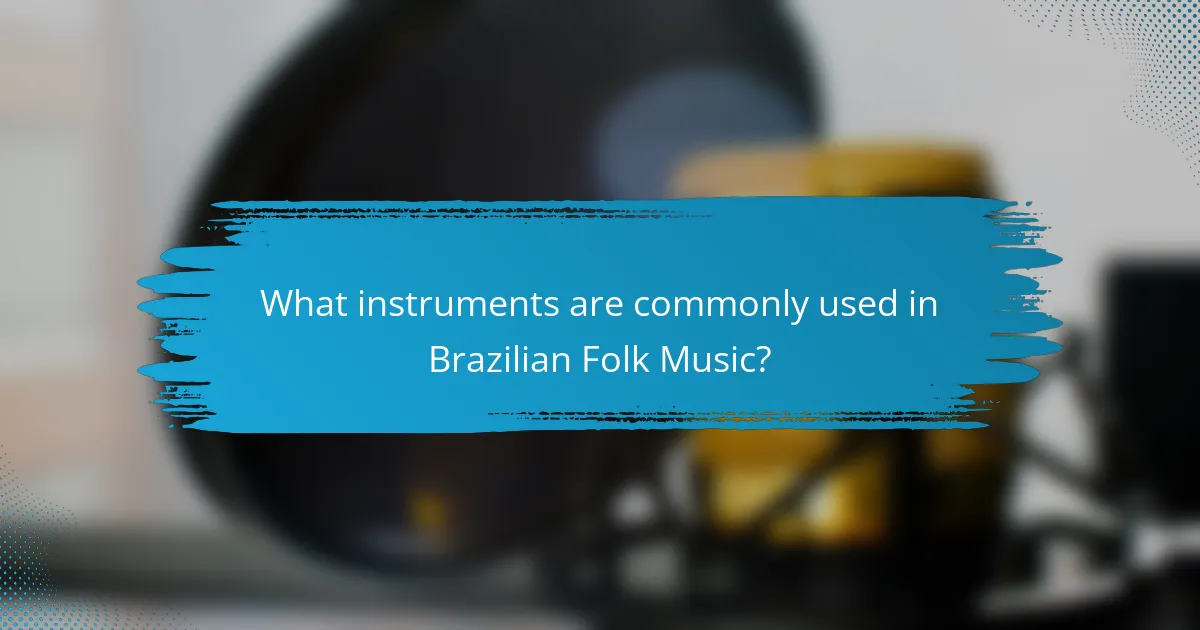
What instruments are commonly used in Brazilian Folk Music?
Common instruments used in Brazilian Folk Music include the berimbau, cavaquinho, and pandeiro. The berimbau is a single-string percussion instrument that is essential in capoeira music. The cavaquinho is a small string instrument similar to a ukulele, often used in samba and choro. The pandeiro is a hand frame drum that plays a crucial role in various Brazilian rhythms. Other instruments include the accordion, used in forró, and the flute, which adds melodic elements to folk songs. Each of these instruments contributes to the rich tapestry of Brazilian folk music, reflecting regional styles and cultural significance.
What traditional instruments are essential to Brazilian Folk Music?
The essential traditional instruments of Brazilian Folk Music include the berimbau, pandeiro, and viola caipira. The berimbau is a single-string percussion instrument used primarily in capoeira. It produces a unique sound that is integral to the rhythm of this martial art. The pandeiro is a hand frame drum that accompanies various folk dances and songs. It has a distinctive jingle sound that enhances the music’s festive atmosphere. The viola caipira, a type of guitar, is key in rural Brazilian music. It has ten strings and is used to play traditional melodies. Each of these instruments contributes to the rich tapestry of Brazilian Folk Music, showcasing regional styles and cultural significance.
How do instruments like the Berimbau contribute to the music?
Instruments like the Berimbau contribute to music by providing rhythm and melody. The Berimbau is a single-string percussion instrument used in Capoeira music. It creates a distinctive sound that guides the movements of Capoeira practitioners. This instrument enhances the cultural expression of Brazilian folk music. It reflects African heritage and influences within Brazilian culture. The Berimbau’s unique timbre and playing techniques enrich the overall musical experience. Its role is essential in maintaining the connection between music and dance in Capoeira. Historical records indicate its use in Brazil dates back to the 19th century, showcasing its long-standing significance.
What role does the Accordion play in various folk styles?
The accordion plays a vital role in various folk styles, particularly in Brazilian music. It serves as a principal instrument in genres like forró and sertanejo. The accordion’s unique sound enhances the rhythmic and melodic structures of these styles. It contributes to the cultural identity of regions such as Northeastern Brazil. Historically, the accordion was introduced by European immigrants in the 19th century. Its adaptability allows it to blend with local instruments and traditions. The instrument is often featured in dance music, providing energy and excitement. Accordion players are celebrated figures in folk music communities, showcasing their skills at festivals and gatherings.
How do modern instruments influence Brazilian Folk Music?
Modern instruments significantly influence Brazilian Folk Music by introducing new sounds and expanding musical possibilities. Instruments like the electric guitar and synthesizers blend with traditional elements. This fusion creates innovative rhythms and melodies. For example, the use of the berimbau alongside electric instruments enhances the depth of capoeira music. Additionally, modern production techniques allow for richer soundscapes. This evolution attracts younger audiences while preserving cultural roots. The integration of modern instruments reflects a dynamic cultural exchange within Brazil’s diverse musical heritage.
What contemporary instruments are being integrated into folk music?
Contemporary instruments being integrated into folk music include electric guitars, synthesizers, and drum machines. These instruments bring a modern sound to traditional folk melodies. Electric guitars add a new dimension to the acoustic sounds typically found in folk. Synthesizers introduce electronic textures and effects, enhancing the overall atmosphere of the music. Drum machines provide a rhythmic foundation that can complement traditional percussion instruments. The integration of these instruments reflects the evolving nature of folk music. This fusion appeals to younger audiences while preserving cultural heritage.
How does technology impact the preservation of traditional sounds?
Technology significantly enhances the preservation of traditional sounds. Digital recording tools capture and archive folk music accurately. These tools include high-quality microphones and audio interfaces. They allow for the documentation of regional styles and instruments. Furthermore, technology facilitates the sharing of traditional music globally. Online platforms enable access to these sounds, reaching wider audiences. Social media also fosters community engagement around traditional music. Preservation efforts are supported by software that restores and enhances audio quality. Overall, technology plays a crucial role in maintaining and promoting the richness of traditional sounds.
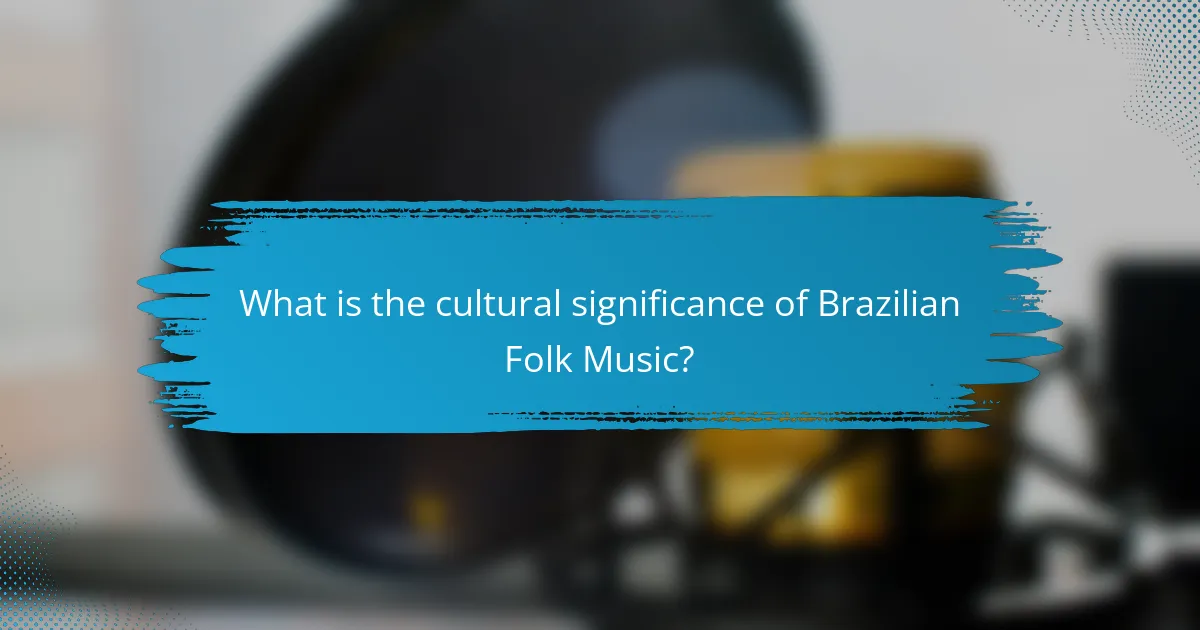
What is the cultural significance of Brazilian Folk Music?
Brazilian folk music holds significant cultural importance as it reflects the country’s diverse heritage. It embodies a blend of indigenous, African, and European influences. This music serves as a medium for storytelling and preserving historical narratives. Traditional genres, such as forró and samba, play vital roles in community identity. Festivals and gatherings often feature folk music, fostering social cohesion. Instruments like the berimbau and accordion are integral to its sound. The music also addresses social issues, offering commentary on Brazilian life. Overall, Brazilian folk music is a key element of national identity and cultural expression.
How does Brazilian Folk Music reflect cultural identity?
Brazilian Folk Music reflects cultural identity through its diverse regional styles and instruments. Each region in Brazil has unique musical traditions that embody local customs and history. For example, the rhythms of Samba from Rio de Janeiro express Afro-Brazilian heritage. In contrast, the Forró from the Northeast showcases influences from Portuguese and indigenous cultures. The use of traditional instruments, such as the Berimbau in Capoeira music, highlights cultural practices and social values. Folk music also serves as a medium for storytelling, preserving narratives of Brazilian history and community struggles. Festivals and cultural events featuring folk music reinforce a sense of belonging among participants. Overall, Brazilian Folk Music is a vital expression of the nation’s multifaceted cultural identity.
What role does folk music play in community celebrations and rituals?
Folk music plays a crucial role in community celebrations and rituals by fostering social cohesion and cultural identity. It serves as a medium for storytelling, passing down traditions and values across generations. In Brazil, folk music is integral to festivals like Festa Junina and Carnival, where it enhances the festive atmosphere. Traditional instruments such as the berimbau and accordion are often used, creating a unique sound that resonates with local heritage. Studies show that participation in folk music activities strengthens community bonds and promotes collective memory. This connection to heritage is vital for cultural preservation in diverse Brazilian regions.
How does it serve as a medium for storytelling and history?
Brazilian folk music serves as a medium for storytelling and history by preserving cultural narratives and traditions. It reflects the experiences and struggles of various communities. Through lyrics, it conveys historical events and social issues. Instruments used in folk music often have regional significance, linking them to specific cultural identities. For example, the berimbau is associated with capoeira and its historical context. Additionally, folk music facilitates oral traditions, passing stories from one generation to the next. Festivals and gatherings showcase these musical forms, reinforcing community bonds and shared histories. Overall, Brazilian folk music encapsulates the rich tapestry of the nation’s cultural heritage.
Why is the preservation of Brazilian Folk Music important?
The preservation of Brazilian Folk Music is important because it maintains cultural heritage. This music reflects the diverse histories and traditions of various Brazilian regions. It serves as a medium for storytelling and the transmission of cultural values. Brazilian Folk Music incorporates unique instruments and rhythms that are integral to national identity. Studies show that folk music contributes to community cohesion and social identity. According to the Brazilian Institute of Geography and Statistics, folk traditions are crucial for understanding Brazil’s multicultural landscape. Preserving this music supports artistic expression and promotes cultural tourism. Ultimately, it fosters appreciation for Brazil’s rich cultural diversity.
What challenges does Brazilian Folk Music face in modern society?
Brazilian Folk Music faces several challenges in modern society. One major challenge is the decline in traditional practices. Younger generations often prefer contemporary music genres over folk traditions. This shift leads to a loss of cultural heritage. Additionally, commercialization poses a threat. Folk music is sometimes altered to fit mainstream tastes, diluting its authenticity. Access to resources for preservation is limited in many regions. Economic factors also hinder artists from pursuing folk music careers. Lastly, globalization increases competition from international music styles. These challenges threaten the survival of Brazilian Folk Music in its original form.
How can communities support the continuation of folk music traditions?
Communities can support the continuation of folk music traditions by actively participating in cultural events. Organizing festivals that showcase local folk music encourages community engagement. Providing platforms for local musicians to perform keeps the traditions alive. Schools can incorporate folk music into their curriculum, educating younger generations. Collaborating with local artists to create workshops fosters skill development. Establishing community groups focused on folk music promotes preservation efforts. Documenting and archiving local folk music helps maintain its historical context. Supporting local artisans who create traditional instruments sustains the craft and the music.
What are some practical ways to engage with Brazilian Folk Music?
Listen to recordings of traditional Brazilian folk music to familiarize yourself with its sounds. Explore regional styles such as forró, samba de roda, and axé. Attend live performances or festivals that showcase Brazilian folk music. Participate in workshops or classes to learn folk instruments like the berimbau or accordion. Join community groups or online forums focused on Brazilian folk music for discussions and resources. Study the history and cultural context of the music to deepen your understanding. Engage with local artists and musicians to support and learn from them.
How can one participate in local folk music events or festivals?
One can participate in local folk music events or festivals by attending scheduled performances. These events are often advertised through community boards, social media, and local newspapers. Engaging with local folk music organizations can also provide information on upcoming events. Volunteering at festivals is another way to participate and immerse oneself in the experience. Many festivals welcome musicians to perform, so aspiring artists should inquire about open mic opportunities or submission processes. Joining folk music groups or clubs can enhance participation through collaborative efforts. Local cultural centers frequently host workshops and gatherings that encourage community involvement in folk music. These avenues create opportunities to connect with the vibrant folk music scene.
What resources are available for learning about Brazilian Folk Music?
Books on Brazilian folk music include “Brazilian Music: A History” by Martha Tupinambá de Ulhôa. Online platforms like YouTube offer tutorials and performances. Websites such as Smithsonian Folkways provide audio samples and educational resources. Academic journals often publish articles on Brazilian music studies. Local music schools may offer classes focused on regional styles. Documentaries about Brazilian culture showcase folk music traditions. Workshops and festivals present opportunities to learn from practitioners. These resources collectively enhance understanding of Brazilian folk music’s diversity and significance.
The main entity of the article is Brazilian folk music, characterized by its rich diversity stemming from various regional styles influenced by Indigenous, African, and European cultures. The article outlines the origins and evolution of Brazilian folk music, highlighting key regional styles such as Samba, Forró, and Axé, as well as the unique instruments like the Berimbau and accordion that define these genres. It also discusses the cultural significance of folk music in reflecting Brazil’s identity, the impact of historical influences, and the importance of preserving these traditions in modern society. Additionally, the article addresses the challenges faced by Brazilian folk music and offers practical ways for communities and individuals to engage with and support these cultural expressions.
